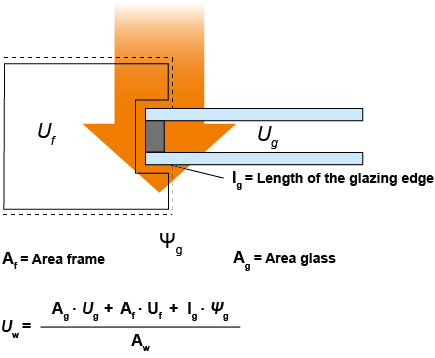What is the Uw value and how is it calculated?
The heat transfer coefficient of a window (Uw) expresses the loss of heat through a building element to the outside air. The lower the value, the better for the structure's energy efficiency!

As the formula for calculating the coefficient shows, the Uw value depends on several factors: window frame, insulating glass unit and glazing edge are the 3 components that influence the Uw value.
The proportions of the window frame and the insulating glass unit are each considered as a product of their specific U value (Uf and Ug) and their respective area (Af and Ag). Because the heat loss obviously occurs across the entire surface area of the window separating inside and outside.
The formula additionally considers the glazing edge as a third factor – i.e. the heat loss at the edge of the insulating glass unit. This is calculated as the product of the length of the glazing edge (lg) and the so-called length-related linear heat transfer coefficient Psi (Ψg). The so-called Psi value stands for the heat loss caused by the interaction of frame, glass and spacer bar.
The spacer bar flows into the Uw value via the Psi value and plays a decisive role in a window’s performance: if this is thermally improved, the thermal bridge in the transitional area from glass to frame or façade profile is minimised – that saves heating and/or cooling energy. It also means that the surface temperature on the glass edge inside the room remains higher, which lowers the risk of hygienically concerning condensation and mould forming.
And how is this Psi value determined?
In addition to a detailed and thus costly Psi value calculation pursuant to DIN EN 10077 for each individual case, the same standard also contains generalised values for all warm edge systems (table E.2).
Much more accurate than generalised values and yet very easy to use are the data sheets of Bundesverband Flachglas: because the data sheet contains a total of 8 representative Psi values per warm edge spacer bar – calculated for 4 frame constructions and 2 representative glass structures each.
The data sheets of Bundesverband Flachglas thus offer not only a considerable simplification for computational proofs, but also offer users verified and specifically comparable figures.